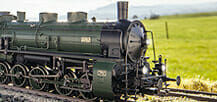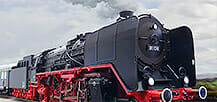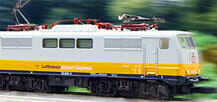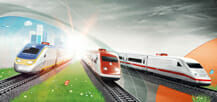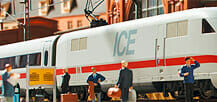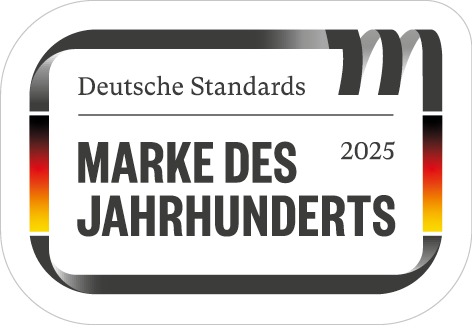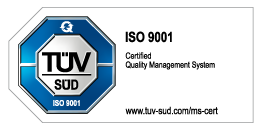Steam Locomotive 66 002
Swift, powerful, frugal, and elegant: The best new construction steam locomotive from the German Federal Railroad came out in 1955 as the class 66. With around 1,000 horsepower performance and a maximum speed of 100 km/h / 63 mph it was intended as a jack-of-all-trades to replace numerous types of locomotives that dated mostly from provincial railroad times. The two prototypes, road numbers 66 001 and 002, were very convincing. They pulled passenger trains on main and branch lines as reliably as well as express trains on the main route Frankfurt – Giessen. Compared to the rapid development of diesel locomotives that were considerably less expensive to maintain, the class 66 had no chance. The service area for the two prototypes of the class 66 was finally taken over starting in 1958 by the class V 100, for example, that the DB bought in large quantities. The class 66 is however a symbol for the high level of German locomotive construction that can also shine in the small scale with the new Märklin model.
Prototype: German Federal Railroad (DB) class 66 passenger tank locomotive. Road number 66 002. The locomotive looks as it did in the mid-Sixties. Based at the railroad maintenance facility in Giessen.
Most Important Facts
| Article No. | 39665 |
|---|---|
| Gauge / Design type | H0 / 1:87 |
| Era | III |
| Kind | Steam Locomotives |
Highlights
- Completely new tooling.
- Buffer capacitor included to bridge over short areas of track without current.
- Factory-installed smoke generator with speed-dependent dynamic smoke exhaust.
- Triple headlights and dual red marker lights that change over with the direction of travel.
- Cab lighting can be controlled digitally.
- Especially intricate metal construction.
- A variety of separately applied details.
- Buffer height conforms to the NEM.
- World of Operation mfx+ digital decoder with extensive light and sound functions.
-
Product description
Model: The locomotive has an mfx+ digital decoder and extensive sound functions. It also has controlled high-efficiency propulsion with a flywheel mounted in the boiler. One axle powered. Two axles powered using side rods. Traction tires. The locomotive is constructed mostly of metal. There is a factory-installed smoke generator with speed-dependent dynamic smoke exhaust. There are triple headlights and dual red marker lights that change over with the direction of travel and that can be controlled digitally. The cab lighting can also be controlled digitally. Maintenance-free, warm white and red LEDs are used for the lighting. A buffer capacitor is included. The minimum radius for operation is 360 mm / 14-3/16". Protective sleeves for the piston rods, brake hoses, heating lines, and prototype coupler imitations are included separately. Length over the buffers approximately 17 cm / 6-11/16".
A car set to go with this locomotive is also being offered under item number 41329 exclusively for Insider members in 2025.
This model can be found in a DC version in the Trix H0 assortment under item number 25660 exclusively for Trix Club members.
Find more Märklin explanation videos on our YouTube Channel
Spare parts for our articles can be found here in our spare parts search.
The steam locomotive, road number 66 002, is being produced in 2025 in a one-time series exclusively only for Insider members.
-
Publications
- Posterprospekt Insider-Modell 2 2025
-
Prototype information
The year is 1948. The railroad also recovered slowly but constantly from the immense war damage that affected the locomotive roster in particular. Although the diesel locomotive had already long since started its victory march in the USA, German engineers at that time believed that steam motive power was indispensable for the near future. The "Technical Committee for Locomotives" set up an extremely ambitious new construction program. A tank locomotive with the class designation 66 was to be built as a fast, powerful general-purpose locomotive for main and branch lines. The new class 66 was based on a design from the firm Henschel in Kassel, Germany. It envisaged running gear with three powered axles, a two-axle trailing truck, and a single-axle pilot truck. The relatively large driving axle diameter of 1,600 mm / 63 inches allowed a maximum speed of 100 km/h / 63 mph and the indexed output still came to 1,170 horsepower. Consideration was also given to the locomotive crew. The class 66 thus had a fully enclosed cab, skylight windows, floor heating, and upholstered seats with backrests. However, the two prototypes were not delivered until 1955 – at a time when the new German Federal Railroad had already decided to step back from steam motive power. Therefore, no regular production order was placed, although the prototypes had already more than fulfilled all of the expectations set for them. They were used in Hesse around Frankfurt and Giessen, even including express trains in regular service. Both locomotives were able to prove their worth for little more than a decade. They were put into storage in 1967. Road number 66 002 was preserved as a museum locomotive for the German Society for Railroad History and can be admired as a well-maintained unit at the museum in Bochum-Dahlhausen.
-
Digital Functions
Control Unit Mobile Station Mobile Station 2 Central Station 1/2 Central Station 3/2*
Mobile Station 2**Headlight(s) Smoke generator Steam locomotive op. sounds Locomotive whistle Direct control Engineer’s cab lighting Headlights locomotive end 2 off Bell Headlight(s): Cab1 End Sound of squealing brakes off Sound of coal being shoveled Conductor's Whistle Letting off Steam Switching maneuver Whistle for switching maneuver Air Pump Water Pump Injectors Sanding Safety Valve Tipping grate Switching range + switching light Generator Sounds Light Function Replenishing water Replenishing coal Replenishing sand Sound of Couplers Engaging Sound of uncoupling Grade crossing * New features of the Central Station 2 (Part No. 60213, 60214 or 60215) with the software update 4.2
** New features of the Mobile Station 2 (Part No. 60657/66955) with the Software Update 3.55
Compatible Products
Warning
ATTENTION: not for children under 15 years
